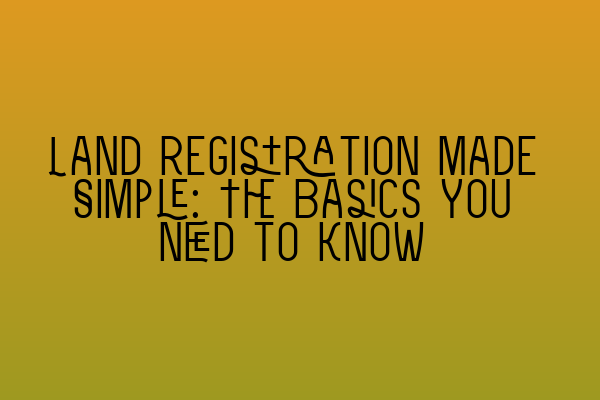Land Registration Made Simple: The Basics You Need to Know
When it comes to the complexities of property law, specifically land registration, it’s essential to have a solid understanding of the basics. Whether you’re a property owner, a solicitor, or simply interested in learning more about land law, this guide will provide you with the key information you need.
What is Land Registration?
Land registration is the process of officially documenting the ownership and interests in a piece of land or property. It involves registering the details of the owner, any rights or restrictions, and any other important information related to the land.
The primary purpose of land registration is to provide certainty and security of ownership. By registering the land, potential buyers can easily determine who owns it, what rights exist, and any restrictions or encumbrances that may be present. This transparency helps facilitate easier transactions and reduces the risk of disputes.
The Land Registry
In the United Kingdom, land registration is overseen by the Land Registry, an independent government agency. The Land Registry maintains the register of land and property ownership, ensuring accuracy and accessibility for all parties involved.
The Land Registry’s records are accessible to the public, and anyone can obtain information about a registered property by conducting a search. This process allows potential buyers, lenders, or other interested parties to gather information about the property before proceeding with a transaction.
Benefits of Land Registration
Land registration offers several benefits, including:
1. Establishing Ownership: Registering land provides a clear and definitive record of ownership, eliminating ambiguity and potential disputes.
2. Protection of Interests: By registering their interests, such as mortgages or easements, individuals and companies can protect their rights in the land.
3. Encouraging Investment: The transparency and certainty provided by land registration make it easier for investors and lenders to assess the value and risk associated with a property, thereby promoting investment.
Registering Land: The Process
To register land, you must submit an application to the Land Registry with all the necessary information and supporting documentation. The application process includes:
1. Completing the Application Form: The Land Registry provides various application forms depending on the circumstances. Ensure you choose the appropriate form for your specific situation.
2. Providing Evidence of Ownership: You will need to provide evidence of your ownership, such as the sale contract, transfer deed, or will. If you’re representing a company, you may need to provide additional documentation.
3. Paying the Fee: There is usually a fee associated with land registration, which varies depending on the value and type of property. Ensure you include payment with your application.
4. Conducting Searches: Before registration, it’s crucial to conduct searches to ensure there are no hidden interests or restrictions on the land. These searches can reveal information about mortgages, easements, or other rights that may affect the property.
5. Submitting the Application: Once you have completed all the necessary steps, you can submit your application to the Land Registry. It will then be reviewed, and if it meets all requirements, the land will be registered in your name.
Common Terminology
To navigate the land registration process effectively, it’s important to familiarize yourself with some common terminology:
1. Title Register: The Title Register is an essential document that contains details about the land, including the legal ownership, any rights (such as rights of way), and any restrictions (such as covenants or charges).
2. Title Plan: The Title Plan is a graphical representation of the property boundaries and key features.
3. Charges Register: The Charges Register contains information about any mortgages, loans, or other charges against the land. It details the lender’s interest and any conditions or restrictions imposed by the charge.
4. Easements: Easements are rights that allow individuals or entities to use or access the land for a particular purpose, such as a right of way or a right to lay pipes or cables.
5. Covenants: Covenants are legal obligations that bind the current and future owners of the land. They can be positive (requiring the landowner to do something) or negative (prohibiting certain actions).
It’s important to consult with a solicitor or property expert to ensure you fully understand these terms and their implications.
Conclusion
Understanding the basics of land registration is essential for all parties involved in property transactions and ownership. By following the registration process outlined by the Land Registry and familiarizing yourself with the terminology, you can ensure a smooth and secure property experience.
If you’re interested in further enhancing your knowledge of property law, we offer a range of SQE 1 and SQE 2 preparation courses. Additionally, if you’re preparing for the SQE exams, we provide practice exam questions and mock exams to help you excel in your studies.
For more information about the SQE exams and important dates, please refer to our related articles:
– SQE 1 Practice Exam Questions
– SQE 1 Practice Mocks FLK1 FLK2
– SQE 2 Preparation Courses
– SQE 1 Preparation Courses
– SRA SQE Exam Dates
At SQE Property Law & Land Law, we are here to support you on your journey to becoming a qualified solicitor. Contact us today to learn more about our services and how we can assist you in achieving your professional goals.
